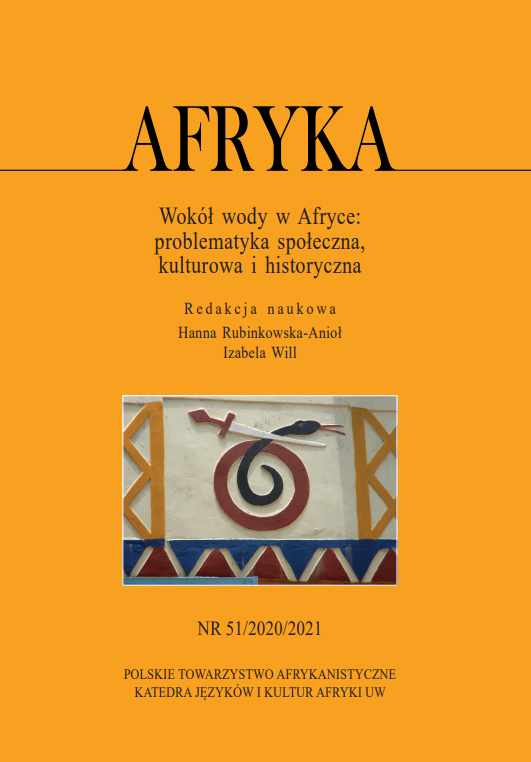Działalność Wangari Muta Maathai. Świadectwo odpowiedzialności za naturę i prawa człowieka z perspektywy ruchu Green Belt Movement
Opublikowane 2022-04-16
Słowa kluczowe
- Wangari Muta Maathai,
- Kenia,
- woda,
- drzewa,
- ochrona środowiska naturalnego
- Green Belt Movement,
- demokracja,
- prawa człowieka ...Więcej
Abstrakt
Tematem artykułu jest działalność Wangari Muta Maathai i jej zaangażowanie w ochronę środowiska naturalnego w Kenii w latach 1977–2011. W niniejszym tekście na przykładzie ruchu Green Belt Movement będę poszukiwać odpowiedzi na pytanie, czy oddolne działania lokalnych społeczności w Afryce mają szansę skutecznie wpłynąć na ochronę środowiska naturalnego, w tym zabezpieczenie niezbędnych zasobów wody pitnej. Stworzona przez Wangari Muta Maathai organizacja szerzyła ideę sadzenia drzew w celu utrzymania równowagi ekosystemu, w tym zapewnienia odpowiednich zasobów czystej wody. Wykorzystanym w artykule tekstem źródłowym jest przede wszystkim autobiografia Wangari Muta Maathai wsparta własnymi obserwacjami autorki poczynionymi podczas pobytów w Kenii w latach 2007, 2008, 2010, 2011–2012.
Bibliografia
- Brooks C., Melanie. 2017. „Grassroots leadership for ecological sustainability, empowerment and political change. Wangari Maathai and the Green Belt Movement”, w: Jeffrey S. Brooks, Anthony H. Normore (red.), Leadership lessons: Great thinkers on equity, justice and education, New York: Teachers College Press, 14–22.
- Gulyani, Sumila; Debabrata Talukdar, Mukami R. Kariuki. 2005. „Water for the urban poor: water markets, household demand and service preferences in Kenya”, Water Supply and Sanitation Sector Board Discussion Paper Series 5, 1, The World Bank Group.
- Kirkscey, Russell. 2007. „Accommodating traditional African values and globalization: Narrative as argument in Wangari Maathai’s Nobel Prize Lecture”. Women and Language 30, 2.
- Maathai, Wangari. 2004. Nobel lecture, https://www.nobelprize.org/prizes/peace/2004/maathai/26050-wangari-maathai-nobel-lecture-2004/, dostęp z dnia 20 stycznia 2021.
- Maathai Muta, Wangari. 2006. Unbowed. One woman’s story. London: Arrow Books.
- Maathai Muta, Wangari. 2009. The challenge for Africa. London: Arrow Books.
- Maathai Muta, Wangari. 2020. Dr. Wangari Maathai plants a forest. Los Angeles: Rebel Girls.
- Marshall, Samantha. 2011. „The water crisis in Kenya: Causes, effects and solutions”, Global Majority E-Journal 2, 1, 31–45.
- Mumma, Albert. 2007. „Kenya’s new water law: an analysis of the implications of Kenya’s Water Act, 2002, for the rural poor”, w: B. van Koppen, M. Giordano, J. Butterworth (red.), Community-based water law and water resource management reform in developing countries, Oxfordshire: Cabi, 158–172.
- nobelprize.org. 2004. https://www.nobelprize.org/prizes/peace/2004/maathai/facts/, dostęp z dnia 15 lutego 2021.
- Ofcansky, Thomas P. 1984. „Kenya forestry under British Colonial Administration, 1895–1963)”. Journal of Forest History 28, 3, 136–143.
- Ogendi, George M.; Issac M. Ong’oa. 2009. „Water policy, accesibility and water ethics in Kenya”. Santa Clara Journal of International Law 1, 7, 177–196.
- Pawełczak, Marek. 2004. Kenia. Warszawa: Trio.
- Prévot, Franck; Aurélia Fronty. 2017. Wangari Maathai: The woman who planted millions of trees. Watertown: Charlesbridge.
- Rateb, Ashraf; Hermas ElSayeb. 2020. „The 2018 long rainy season in Kenya: Hydrological changes and correlated land subsidence”. Remote Sensing 12, 1–16.
- reliefweb. 2005. „Kenya: At least 14 killed in clashes over water”. https://reliefweb.int/report/kenya/kenya-least-14-killed-clashes-over-water, dostęp z dnia 23 stycznia 2021.
- Roy, L. Jessica; Ben Crow; Brent Swallow. 2005. „Getting access to adequate water: Community organizing, women and social change in Western Kenya”. International workshop on African Water Laws: Plural Legislative Frameworks for Rural Water Management
- in Africa, South Africa. https://dlc.dlib.indiana.edu/dlc/bitstream/handle/10535/5058/ROY-J.pdf?sequence=1, dostęp z dnia 23 stycznia 2021.
- Understanding the Kenia 2016 Water Act. 2016. „2030 Water Resources Group”. https://www.2030wrg.org/wp-content/uploads/2016/12/Understanding-the-Kenyan-Water-Act-2016.pdf, dostęp z dnia 19 stycznia 2021.
- [The] Water Act. 2016. Kenya Gazette Supplement 164. https://wra.go.ke/wp-content/uploads/2019/05/The_Water_Act_2016.pdf, dostęp z dnia 19 stycznia 2021.
- WASREB. 2020. https://wasreb.go.ke/national-water-services-strategy/, dostęp z dnia 15 lutego 2021.
- water.org. 2021. https://water.org/our-impact/where-we-work/kenya/, dostęp z dnia 18 stycznia 2021.
- WHO/UNICEF Joint Monitoring Report. 2019. https://www.unicef.org/kenya/water-sanitation-and-hygiene#:~:text=The%20WASH%20joint%20monitoring%20programme-for%20the%20survival%20of%20, dostęp z dnia 18 stycznia 2021.
- World Bank. 2004. Towards a water-secure Kenya: Water resources sector memorandum. Washington, DC. https://openknowledge.worldbank.org/handle/10986/15546 License: CC BY 3.0 IGO, dostęp z dnia 20 stycznia 2021.
